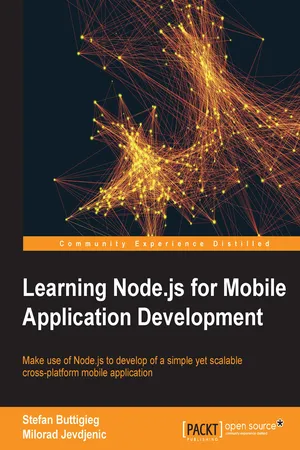
- 248 pages
- English
- ePUB (mobile friendly)
- Available on iOS & Android
Learning Node.js for Mobile Application Development
About This Book
Make use of Node.js to learn the development of a simple yet scalable cross-platform mobile application
About This Book
- Use Node.js to satisfy the core backend requirements of modern apps, including user management, security, data access, and real-time data communication
- Build practical real-world mobile applications, which will give you the necessary knowledge to build your very own mobile solutions
- Step-by-step development of projects using Ionic Framework as the frontend and Node.js for the backend supported by a MongoDB database
Who This Book Is For
This book is intended for web developers of all levels of expertise who want to deep dive into cross-platform mobile application development without going through the pains of understanding the languages and native frameworks that form an integral part of developing for different mobile platforms.
This book is also for you if you are a developer who wants to capitalize on the MobileFirst strategy and so are going to use JavaScript for your complete stack.
What You Will Learn
- Develop an API from scratch
- Set up a MongoDB Database as part of your mobile application backend
- Deploy a cross-platform mobile application from the command line
- Incorporate features within your mobile application that use native phone features such as a gyroscope, GPS, and accelerometer
- Implement mobile applications that use web-enabled APIs
- Build a mobile application with real-time chat messaging features
- Develop a secure mobile application that is capable of functioning with real-time data
In Detail
Node.js is a massively popular JavaScript library that lets you use JavaScript to easily program scalable network applications and web services. People approaching Node.js for the first time are often attracted by its efficiency, scalability, and the fact that it's based on JavaScript, the language of the Web, which means that developers can use the same language to write backend code. Also, it's increasingly being seen as a "modern" replacement for PHP in web development, which relies on fast-paced data exchange. The growing community and the large amount of available modules makes Node.js one of the most attractive development environments.
This book takes a step-wise and incremental approach toward developing cross-platform mobile technologies using existing web technologies. This will allow you to truly understand and become proficient in developing cross-platform mobile applications with Node.js, Ionic Framework, and MongoDB.
The book starts off by introducing all the necessary requirements and knowledge to build a mobile application with a companion web service. It covers the ability to create an API from scratch and implement a comprehensive user database that will give you the opportunity to offer a mobile application with a personalized experience.
Midway through the book, you will learn the basic processes to create a successful mobile application. You will also gain higher-level knowledge, allowing you to develop a functional and secure mobile application to ensure a seamless user experience for end users.
Finally, the book ends with more advanced projects, which will bring together all the knowledge and expertise developed in the previous chapters to create a practical and functional mobile-application that has useful real-world features.
Style and approach
This book is an easy-to-follow guide that takes a step-wise approach in giving expertise and knowledge to help you truly understand what is needed to create a memorable user experience for end users. Each topic is placed in the context of the bigger picture, that is, to create cross-platform mobile applications using existing technologies.
Frequently asked questions
Information
Learning Node.js for Mobile Application Development
Table of Contents
Learning Node.js for Mobile Application Development
Table of contents
- Learning Node.js for Mobile Application Development